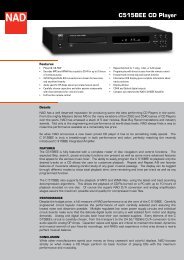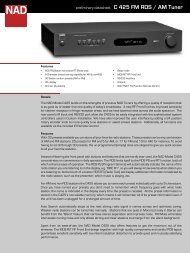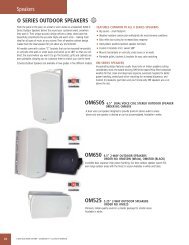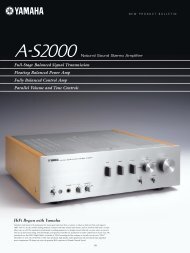McIntosh C1000 Stereophile Review - The Listening Post
McIntosh C1000 Stereophile Review - The Listening Post
McIntosh C1000 Stereophile Review - The Listening Post
Create successful ePaper yourself
Turn your PDF publications into a flip-book with our unique Google optimized e-Paper software.
MCINTOSH <strong>C1000</strong>bass equalizer was a nerve-rackingexperience requiring the combinedbrain power of three not-stupid individuals.<strong>The</strong> instructions try to beexplicit, but too few examples are provided—andif you don’t get it right, youget no sound.Among the Setup features are inputleveltrim, so that the volume doesn’t“jump” between inputs; a Pass Thrumode for use in a multichannel sound orhome theater system; adjustments forthe fluorescent display and meter brightness;input title reassignment (forinstance, if you have a DVD playerplugged into the Aux input, you canchange that input’s label to read“DVD”). And, of course, in Setup modeyou can change MM capacitance andMC resistive loading. You can even setthe <strong>C1000</strong> for mono operation, via theSetup menu or the remote control.Actually, there are two remote controls:a plastic, full-function, A/V receiver typethat can control other <strong>McIntosh</strong> products,and a hefty model of extruded,anodized aluminum that controls basicfunctionality. <strong>The</strong> latter is the one you’lluse most of the time, especially whenyou show off your <strong>C1000</strong> to friends.Using the <strong>C1000</strong>When you have both the <strong>C1000</strong>Psolid-state and <strong>C1000</strong>T tube preampsconnected, the <strong>C1000</strong>C will recognizethe fact and double your input-selectionoptions. Scrolling through theseoptions can be tedious, especially whenyou’re not using all of them: CD1,D/A, PH/MM1, PH/MC1, DVD2,Aux2, Tuner2, Srvr2, CDR2, CD2,PH/MM2, PH/MC2, CD3, Srvr3,CDR3, Srvr1, CDR1. Early on I reassignedone input but can’t remembernow what I did. I kept forgetting whatwas where, and often did a lot of huntingto find the input I wanted, but itwas hardly painful. Otherwise, onceeverything’s up and running and programmedto your liking (a big otherwise),using the <strong>C1000</strong> is easy.<strong>The</strong> <strong>C1000</strong>C switched between thetubed and solid-state preamps seamlessly,the meters on each are activatedonly when that preamp is selected. Asfor which you’ll end up using for eachsource, that will take some experimenting—onepreamp or the other willsurely be more complementary to eachTHE <strong>C1000</strong>P SOLID-STATE PREAMP DELIVERED ABLOOM USUALLY ASSOCIATED WITH TUBED GEAR,WHILE THE TUBED <strong>C1000</strong>T PRODUCED THE EVEN-HANDED TONAL BALANCE AND NEUTRALITY ONEUSUALLY ASSOCIATES WITH SOLID-STATE.source. That said, the tubed and solidstatepreamps sounded more alike thannot, which is how it should be.A sonic delicacyWhile the <strong>C1000</strong> outputs single-endedsignals, I felt it important also to listenin balanced mode, so I borrowed a pairof mbl 9007 balanced monoblockpower amplifiers (review in theworks). I also auditioned the <strong>C1000</strong>using my reference Musical FidelitykW single-ended monoblocks.<strong>The</strong> <strong>C1000</strong>’s sound remained consistentrun either balanced or singleended.<strong>The</strong> <strong>C1000</strong>P solid-state preampdelivered a bloom usually associatedmeasurements, continuedaudioband for both the ’P and ’T, the former offering avery low 0.001% or less compared with the latter’s stilllow0.016%. Into 600 ohms, however, these graphs showthat the actual THD rises at both very low and very highfrequencies, though not to any extent that might evenbegin to be audible.At normal levels, spectral analysis reveals that the harmoniccontent is vanishingly low for both preamps:0.0005% (true sum of the harmonics; fig.9, <strong>C1000</strong>P;fig.10, <strong>C1000</strong>T). <strong>The</strong> increase in THD at low frequenciesand high levels into 600 ohms was due primarily to anincrease in the subjectively innocuous third harmonicFig.9<strong>McIntosh</strong> <strong>C1000</strong>P, unbalanced spectrum of 1kHz sinewave,DC–10kHz, at 1V into 8k ohms (linear frequency scale).Fig.10 <strong>McIntosh</strong> <strong>C1000</strong>T, unbalanced spectrum of 1kHz sinewave,DC–10kHz, at 1V into 8k ohms (linear frequency scale).www.<strong>Stereophile</strong>.com, August 2006 5













